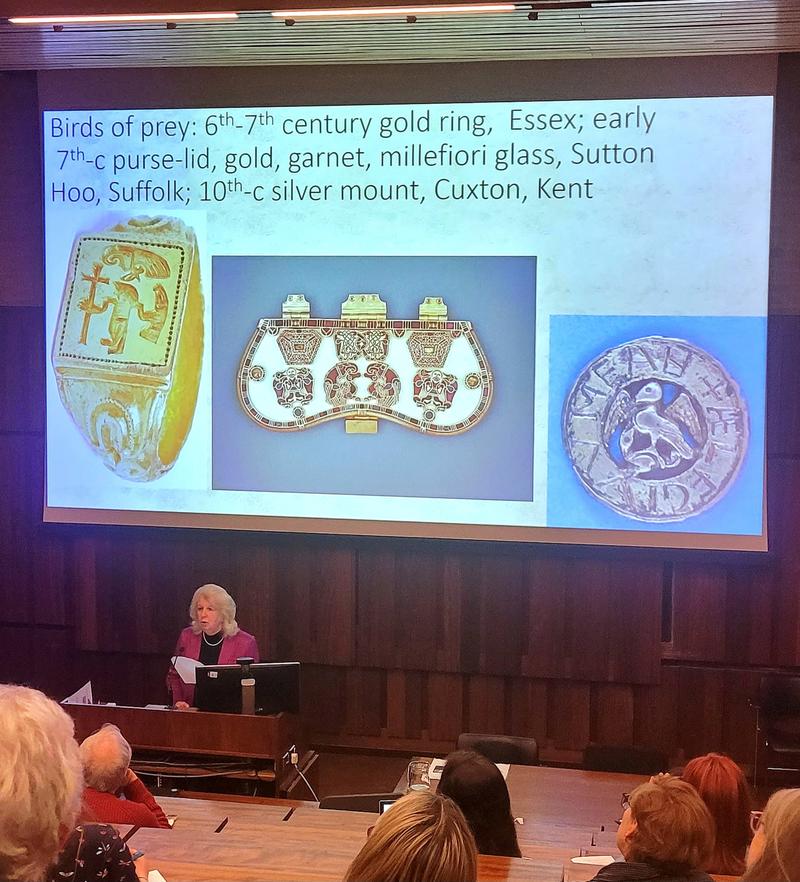The Inaugural Dorothy Whitelock Lecture

The inaugural Dorothy Whitelock Lecture took place on Wednesday 4th December 2024 in the Faculty of English, marking the first in a series of lectures to be held annually at the University of Oxford in celebration of Dorothy Whitelock. Professor Whitelock held posts at the universities of Cambridge and Uppsala as well as Oxford, where she stayed for 21 years before moving back to Cambridge to take up the Elrington and Bosworth chair of Anglo-Saxon. Her advancement to our understanding of early English history, society and literature cannot be understated: her editions of Anglo-Saxon Wills (1930), The Peterborough Manuscript of the Anglo-Saxon Chronicle (1954), Wulfstan’s Sermo Lupi ad Anglos (1939) and the monumental English Historical Documents: Volume 1 c. 500–1042 (1955) remain standard reference works, while her monographs The Beginnings of English Society (1941) and The Audience of ‘Beowulf’ (1951) had a transformative effect on the study of early medieval English culture.
Following a short introduction by Helen Appleton and Colleen Curran, who explained the rationale behind this lecture series, the inaugural lecture was delivered by Gale Owen-Crocker, Professor Emerita at the University of Manchester. Prof. Gale Owen-Crocker was previously Professor of Anglo-Saxon Culture and Director of the Manchester Centre for Anglo-Saxon Studies. Throughout her career, Professor Owen-Crocker has made significant contributions to the field of early English history and culture, with particularly seminal work on medieval dress and textile. Her book, Dress in Anglo-Saxon England, was first published in 1986 and has since been rewritten and republished twice, in 2004 and 2010. She is currently working on two projects: one on the Bayeux Tapestry and the other on Animalia. These two interests dovetailed in her lecture, which was entitled ‘Social History and False Friends: From Anglo-Saxon Wills to the Bayeux Tapestry via Material Culture’.
Professor Owen-Crocker delivered a detailed and entertaining talk, demonstrating a breadth of knowledge that can only be amassed over a long and varied career. She recounted how she felt as though, despite never having met Professor Whitelock, she had stood at her shoulder throughout her career, going on to describe how ‘Dorothy Whitelock unlocked an opening though which we can peep at history’. Professor Owen-Crocker’s talk nudged this opening a little further ajar: she showed us seventh-century grave-goods from Sutton-Hoo, illuminations from the eleventh-century illustrated Old English Hexateuch, Maaseik embroideries from the early ninth century and motifs from the tenth-century Rider Silk. She also read excerpts from Beowulf as well as from early English women’s wills, drawing from Whitelock’s Anglo-Saxon Wills (1930). Expertly synthesising this wealth of material and literary evidence, the lecture constructed meaning from the Bayeux Tapestry’s main scenes, as well as the microdetails within its borders. The lecture was chaired by Professor Francis Leneghan.
As well as a recognition of Dorothy Whitelock’s primacy in Anglo-Saxon scholarship, the lecture was an ode to the scholarship of the Bayeux Tapestry designer. Professor Owen-Crocker showcased how its references, manifestations and manipulations of other sources create layer upon layer of meaning. The Tapestry, we learned, is not just a work of artistry, or a historical account, or even a visual story, but a feat of scholarly mastery. It does not simply relate historical narratives but imbues them with a myriad of meanings, tones and voices which –– as Professor Owen-Crocker showed –– when brought into dialogue with other material and literary sources, tell a new story altogether. The Bayeux artist’s knowledge of animal symbolism is threaded through the whole piece: Harold Godwinson’s depiction as a falconer emblematises a visual depiction of his fluctuating aristocratic status, for instance, while a horse’s genitalia (or its absence) acts as a signifier of the masculinity and power of its rider. The artist sews, at times, with an adroit irony: the Old English Hexateuch illustration depicting Abraham cooking for spiritual visitors is embroidered and adapted into a scene of unwilling English farmers being led to the slaughter. The measured consideration within the threads of each detail of the nearly 70 metre Tapestry was aptly mirrored by Professor Owen-Crocker’s care in unpicking each of these details.
With over 140 in attendance in-person and online, the lecture was a very fitting tribute to the work of Dorothy Whitelock, as one pioneering female scholar of Anglo-Saxon culture delivered the inaugural lecture in honour of another. Within the years to come, hopefully this new tradition will continue to showcase the passing on of knowledge between scholars who continue to draw from the considerable knowledge of Professor Whitelock’s legacy. Each lecture will be published on the English Faculty’s website. To find out more about the series, see here.
— Grace O’Duffy
DPhil candidate in Old Norse



